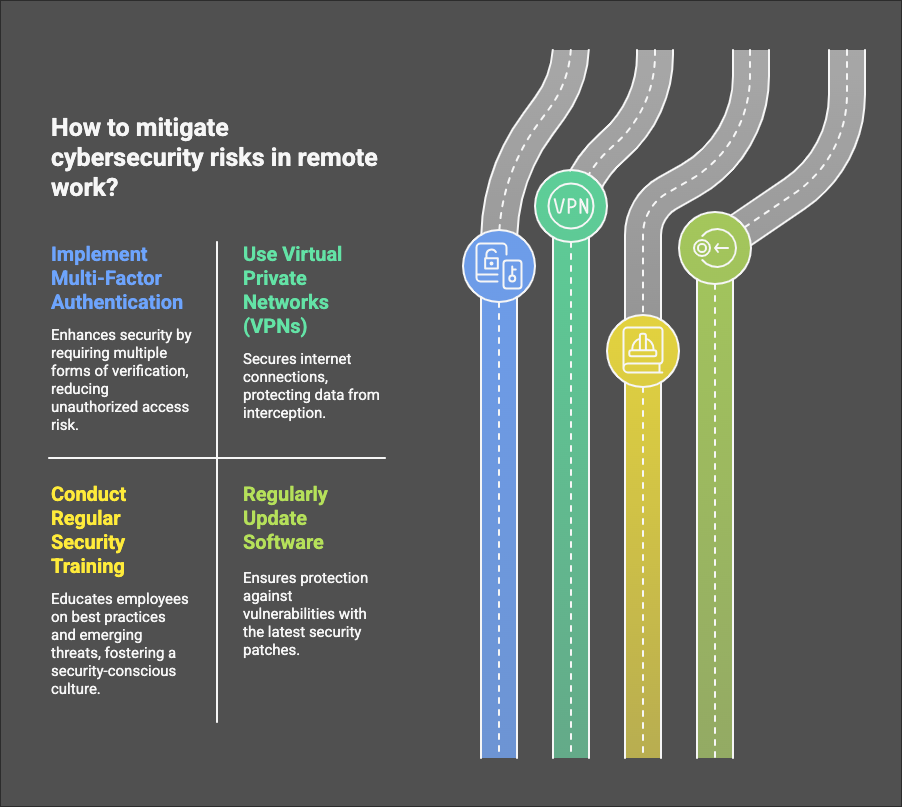Cybersecurity Risks in Remote Work: Best Practices for Protecting Sensitive Data
 Scribesquad
Scribesquad
The New Era of Work: Security Challenges in a Digital World
The shift to remote work has redefined workplace dynamics. While it offers flexibility, cost savings, and global collaboration, it also exposes organizations to security risks. A 2023 Cybersecurity Report by IBM found that remote work was a major contributor to 60% of data breaches. With cyber threats rising, individuals and businesses must prioritize security to safeguard sensitive information.
Common Cybersecurity Risks in Remote Work
1. Weak Passwords and Credential Theft
A weak password is a hacker’s best friend. According to Verizon's Data Breach Investigations Report, 81% of hacking-related breaches result from compromised credentials.
How to Avoid:
Use multi-factor authentication (MFA).
Create strong, unique passwords with a mix of letters, numbers, and symbols.
Implement a password manager to store credentials securely.
2. Unsecured Wi-Fi Networks
Public Wi-Fi networks are breeding grounds for cybercriminals. Attackers can intercept data or launch man-in-the-middle (MITM) attacks to steal sensitive information.
How to Avoid:
Use a virtual private network (VPN) to encrypt data.
Avoid accessing sensitive files over public hotspots.
Turn off automatic Wi-Fi connections on devices.
3. Phishing Attacks
Cybercriminals leverage sophisticated phishing campaigns to trick employees into revealing login credentials or downloading malware. Reports indicate that 90% of security breaches start with phishing emails.
How to Avoid:
Verify email senders before clicking links.
Educate employees on spotting suspicious messages.
Implement email filtering tools to block phishing attempts.
4. Unsecured Personal Devices
Many remote workers use personal laptops and mobile devices without adequate security controls. This increases the risk of malware infections and unauthorized access.
How to Avoid:
Enforce endpoint security policies.
Keep all devices updated with the latest security patches.
Use remote device management tools to monitor access.
5. Lack of Data Encryption
Without proper encryption, sensitive data is vulnerable to interception. A study by Ponemon Institute found that 67% of companies fail to encrypt remote work data adequately.
How to Avoid:
Enable full-disk encryption on all devices.
Use end-to-end encryption for communication tools.
Store critical data on secure cloud platforms.
Best Practices for Strengthening Remote Work Security
1. Develop a Comprehensive Security Policy
A clear cybersecurity policy should outline:
Secure access control measures.
Data handling and encryption standards.
Incident response protocols for potential breaches.
2. Regular Security Training for Employees
Human error remains one of the weakest links in cybersecurity. Regular training programs help employees identify and prevent security threats.
3. Utilize Zero Trust Architecture
Zero Trust operates on a "never trust, always verify" principle, ensuring:
Strict identity verification before granting access.
Limited user privileges to minimize risks.
Continuous monitoring for suspicious activities.
4. Secure Cloud Storage Solutions
Cloud-based collaboration tools must have:
Multi-layer authentication.
Data loss prevention (DLP) mechanisms.
Automatic backup and recovery features.
5. Monitor and Update Security Tools
Cyber threats evolve daily, making it essential to update security tools. Businesses should:
Install next-generation firewalls (NGFWs).
Deploy intrusion detection systems (IDS).
Use AI-driven threat detection for proactive defense.
The Future of Cybersecurity in Remote Work
As organizations continue embracing remote work, security strategies must evolve. Integrating AI-driven threat detection, zero-trust frameworks, and enhanced encryption will mitigate risks. By staying vigilant and implementing best practices, businesses can create a secure remote work environment that fosters productivity without compromising data integrity.
Stay Ahead of Cyber Threats
Remote work is here to stay. Ensure your digital workspace is fortified with cutting-edge security solutions. Want to learn more about the latest cybersecurity strategies? Visit our blog for in-depth insights!
Subscribe to my newsletter
Read articles from Scribesquad directly inside your inbox. Subscribe to the newsletter, and don't miss out.
Written by

Scribesquad
Scribesquad
Writing is a lifestyle. I am about everything research and technology